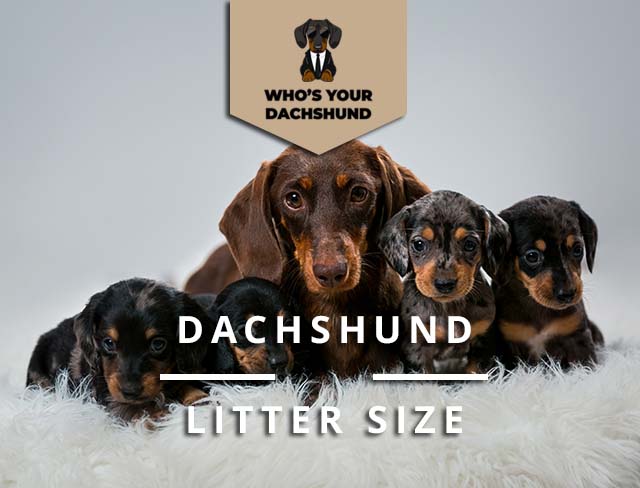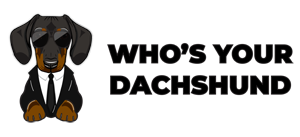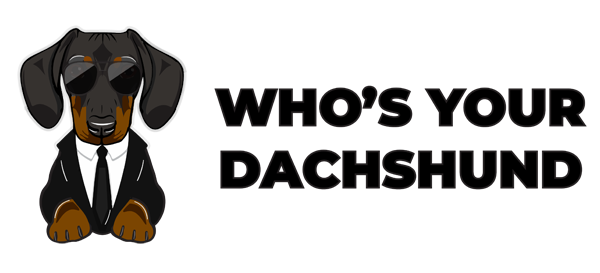
How Many Puppies Do Dachshunds Have?
Dachshunds usually have around six to eight puppies in a litter. Dachshund puppies usually weigh around two or three pounds at birth. The average amount of time that the female will carry the puppies before they are delivered is somewhere around ten weeks, but many factors could cause the pregnancy to stay longer than this period. They will need to be kept in a warm environment to grow properly. The puppies’ size will depend on the mother’s breed, her parents’ genetics, and how many puppies she has carried from previous litters. For example, a female dachshund in heat will usually have one litter averaging six puppies. A Dachshund with a genetic predisposition to having larger litters may carry ten or more puppies but usually have fewer than twelve. The percentages of puppies born alive will be more significant in larger litters.
Dachshunds are known for being long and thin dogs with short legs and long backs. They are often confused with other breeds, such as Beagles, because of their similar appearance. Dachshunds have a long, tapered tail set low between the dog’s back legs. Like all other Terriers, Dachshunds have a thick, double coat that is dense and waterproof. The Dachshund’s outer coat usually has two guard hairs and a softer undercoat. These dogs are known for their tiny ears, which can only be seen when they are alert or excited.
How Many Puppies Do Miniature Dachshunds Have?
The average litter size of a miniature dachshund is 4-6 puppies. The puppies’ actual newborn size varies but is usually between 7-9 inches long (20 to 26 cm) and 3-4 pounds (1.4kg). The miniature Dachshund’s height changes dramatically during its first year of life. Initially, they are extremely short, but they are almost as tall as their parents by their first dachshund birthday. A full-grown miniature Dachshund stands 15-16 inches tall at the shoulders and between 14 and 16 inches for a female.
Why is a Larger Litter Size Better?
Larger litters are better because they mean the mother will give more love and attention to each of her kittens. Larger litters also mean that there will be more opportunities for cats to find homes, and the mother will be able to protect and teach her litter more than if she was in the process of raising many small pups. If a mother is in good health, her puppies grow steadily. By this, we mean that the rate at which each puppy grows is similar to other puppies’ growth rate.
Average Litter Size of Dachshunds
Dachshunds typically have litters of six to eleven puppies. Typically, litter sizes range from 10-12 puppies. Dachshunds can have smaller litter sizes, with six puppies being the average. Smaller litters of only two to five puppies are commonly seen in dachshunds. Larger litters are also seen, but not as often as medium-sized litters. Huge litters of 15-16 puppies occasionally occur in dachshunds. They can have larger litter sizes, but this is rare.
The Dachshund puppy is born with eyes that are 20 percent open. Their eyes then open to 50 percent and fully open within 24 hours. Dachshunds have one of the most prolonged gestation periods of all canine breeds, at a time of approximately nine months. The eye color is usually brown but can be any color.
As the name implies, the Dachshund has a long body ranging from 36 to 50 cm (14 to 19 inches). The average weight ranges from 10-22 kg (22-48 lbs). Dachshunds can weigh anywhere from 10-23 lbs. The Dachshund’s back usually is straight, and the ears are short, hanging close to the head. Depending on the coat, their colors range from light tan to red, chocolate brown, or black. Dachshunds can be dapple gray (also known as double dapple) or piebald (also known as split-colored).
Is it possible for the breeder to increase the size of a litter?
Breeders can increase the size of a litter, but they have to breed a specific dog type. The best way to get the size you want is to choose your breed carefully. If you want a very large dachshund, then choose a long-bodied dog. Certain dogs can make the litter larger, and they have to be careful when breeding these dogs together because of the puppies’ sizes.
The more miniature Dachshunds can be used to get specific litter sizes.
Dachsie’s were bred to hunt badgers, whose digging creates underground caves, which is the smellier of the two types in Germany. They are not born with this instinctual desire to attack badgers but are taught this by their mother. The Dachsies use their high energy levels and speed to hunt and force the badger into their underground burrow.
The Dachshund breed is a short-legged dog that gives the appearance of being stockier than they are. As some may know, the Dachshund is a very energetic breed, and they love to run and walk around. Their height per pound is smaller than other dogs because of their size, making them look shorter than they are.
What to Expect During Dachshund Pregnancy?
At the time of pregnancies, the pregnant dog must follow a healthy lifestyle for a healthy delivery and healthy puppies. With that said, it is vital to take the following precautions:
- It is a critical time for your dog. It is best to schedule appointments with the veterinarian frequently so that they can check on the health of your puppy as it grows and develops. Please contact a local vet if something does not feel right! (For instance, if your dog begins to be in pain or is not moving well).
- As a pet owner, you are accountable for your dog’s health. It is your responsibility to make sure that she receives the proper nutrition. It means food and treats that are appropriate for her weight. If you don’t have a clue, consult with a veterinarian! Remember, even if your dog does eat the same type of food all the time, it may not be best suited for her body at this time.
- Your veterinarian can help you get your dog in shape for the delivery time. If she is a puppy, you can keep her on a leash and play with her often to get her going and getting ready for pregnancies. As she gets closer to the delivery time, you should begin to walk her more often. Be sure to feed her treats like carrots or kibble during these walks, but DO NOT give her large amounts of snacks – that can only cause harm!
- Dachshunds are prone to specific health problems as they get older and age. As a pet owner, you are accountable for ensuring that your dog receives the proper care as she gets older. Even if you always have your little doxie pups to take care of, it would be wise to check up on her from time to time so that she can continue to grow. Ultrasound is the best way to evaluate your older dog’s heart and lungs.
What Is The Percentage Of Puppies That Survive After Birth?
The percentage of puppies that survive after birth is usually around 70%. It will depend on the overall health of the puppies. The puppies at the bottom of the litter will most likely die after birth. However, some factors can increase the survival rate of a puppy. The mother will be more likely to nurture and keep the puppies alive if she has not had a cesarean section. The puppies will also have a higher chance of surviving if the mother does not have an infection. The mother, Dachshund, will need to be kept in a clean and warm environment to maintain her body temperature. A dog with a low body temperature is more likely to reject the puppies. Puppies can be rejected when still in the uterus, during delivery, or after birth.
Dachshund Whelping And Fertility
Dachshund whelping and fertility are two things that are often confused with one another. Whelping is the birth of a litter of puppies, typically five or six, while the term fertility refers to the length of time that a bitch remains in the heat after her first heat.
Dachshund Whelping Facts:
- Dachshunds can have litters any time of the year. However, if it is the first time for a doxie mommy, then keep an eye out for signs of heat during the spring and summer months (March through October). Hint: hot summer days in the south are a great indicator of heat.
- Dachshunds are a very fertile breed, and whelping is not a problem for most dogs. “Whelping” refers to the process of giving birth; most Dachshunds have an instinct to nurture the litter, and maternal behavior is well-developed.
- Dachshunds typically have 7 (sometimes 8) puppies in a whole litter, with 4-6 being average. The typical gestation period is 63 days, with a standard offspring size of 5. However, there have been larger litters, with one whelping having 14 puppies (stillborn). Another had 11 live puppies. Another whelping had ten puppies, and another had nine live ones plus one stillborn. The exact number of puppies in a litter can vary from 4 to 8, but the average is 4 to 6.
- Dachshunds are usually born with fur between the toes. If you wish for a different color, you should wait until your puppy matures and sheds its coat. Some colors have more variation than others, so always expect the unexpected.
If you wish for different coat colors, wait until your puppy matures and sheds its coat. If you wish for a different color, wait until your puppy matures and sheds its coat. If you wish for different coat colors, wait until your puppy matures and sheds its coat. If you wish for a different color, wait until your puppy matures and sheds its coat.
Dachshund Fertility Facts
Dachshunds are an intelligent breed of dog, loyal and loving, but they also have their own set of challenges! Here we will explore the basics of dachshund fertility, avoid it, and deal with it.
Seven weeks is the earliest for a dachshund to leave the nest; this is when they do facial tattooing, which means they are ready to be weaned. They will start being weaned off milk and gradually be fed more and more solid food so that at eight weeks of age, they’ll be completely ready to eat solid foods only.
Dachshunds are generally reasonably quiet dogs, especially compared to larger breeds. However, they are prone to sore muscles and back pain because of their long backs. Besides, the Dachshund’s small stature and long bodies put a strain on their organs, which means they can sometimes be prone to heart disease or breathing difficulties.
An average grown Dachshund will have medium fur that is relatively heavy for its size. A good grooming schedule using a slicker brush should be part of your average dachshund care regimen.
The Proportion Of Puppies
The proportion of puppies in dachshunds is about 40% in the first breedings. The breed tends to deliver relatively large puppies, with the average weight being 100 to 200 grams. Some stillborn puppies were recorded as reaching six inches in length. These large litters’ birth can cause some minor problems for the mother. These issues are typically solved within a few days, and in severe cases, the mother will need to be removed from the litter for a couple of hours so she can rest.
The Popular Breeds Dachshunds
One of the easiest breeds to breed is the Dachshund. All they need is a warm place and time to rest, feed, and care for them. The popular breeds for Dachshunds are the min-pin. This breed has a bad reputation for being very loud, but the mini dachshunds are not like that. They do bark from time to time (because they are dogs), but it is not constantly. Coat types of Dachshunds are long-haired, smooth-haired, and wire-haired. They can be in reds, black & tan standard size dapple, and piebalds. The AKC also includes cream and chocolate in the coat types.
The coat is probably the most distinctive feature of the Dachshund breeds, and they come in three different coat varieties: longhair, smooth hair, and double dapple piebald. Dachshund breedings are usually done in the spring or summer. Dogs are not bred every year, but only when a litter is due. The bitch is denoted by a heat cycle for two weeks, and then the female dog goes into heat again for two weeks before breeding takes place. A dachshund typically takes three years to mature, but they mature in various ways depending on their coat type. The process of making sure that they keep their personality intact as they get older is called “breaking.
The Dachshund has been a long-time companion and working dog. The Dachshund has been used in cattle herding, hunting, guard dogs, and search & rescue.
Dachshunds Breed Standards
Dachshunds are a small to medium-sized dog breed raised originally in Germany. They have short legs and long bodies, with well-muscled chests and necks. Their backsides tend to be plump, and their tails are short to medium in length. They have a long, soft, and flexible coat with a weather-resistant guard coat over a dense undercoat of softer hair. The outer coat is straight and harsh against the skin except for the ears, tail tip, feet, and pads of the feet, which may be “rough.” Dachshund breedings are art, and their coats can vary greatly. Dachshunds should have a supple, strong, and healthy coat free of mats from chronic skin conditions such as fungus or poor grooming. A dachshund’s coat is usually bi-colored throughout, but a tri-colored or multi-colored dog is not considered a Dachshund. Dachshunds are small, tiny dogs known by their nicknames “doxies.” Their coats are short and come in many colors. Generally, they are long-bodied dogs with dewclaws originating from Germany, and they have since spread to many other countries around the world. There are three recognized sizes in which these dogs can be categorized; Miniature, Standard, and Giant. The two most common sizes are the Miniature and Standard.
Type of Dachshund
There are three types of Dachshunds. The first is the standard longhaired dachshunds, which have a varieties colors and patterns such as red, black, cream, and tan. The longhaired Dachshunds are best for the show, while smooth-haired dachshunds are considered miniature dachshunds. There are also longhaired mini dachshunds and smooth-haired minis. They are a lot smaller than the typical longhaired and short hair Dachshunds. However, they still have the same coloring and patterns as their standard-length counterparts. Smooth Dachshunds are thought of as the most beautiful dachshunds as they have a sleek, long, and clean coat. They are also considered the easiest to groom.
The second type in the Dachshund family is the miniature Dachshund. The miniature Dachshund, or “doxie,” will have a short coat and can easily be mistaken for a smaller version of a housecat. This breed will not have any long hair on its body at all.
The third type of Dachshund is the wire-haired Dachshunds. The wirehair Dachshunds or doxie is a medium-sized dog that will have a wiry, long straight, smooth coat on its body. This breed of Dachshunds is not suitable for a first-time owner as they tend to be strong-willed and can be hard to train. Because the wirehair doxie has a double coat, grooming and washing the dog is a lot more complicated. They are known for their hypoallergenic nature, so they are not suitable for first-time owners.
The Inbreeding Coefficients for Dachshunds
According to a UK Kennel Clubs study, Dachshunds’ inbreeding coefficient is about 8%. Compared to the Labrador, this means they are less likely to breed health issues such as hip dysplasia and progressive retinal atrophy. They also tend to have better athletic prowess due to their shorter legs and more compact body that allows them to run at a higher top speed than their larger cousins. Dachshund Kennel Clubs have also studied the inbreeding coefficient of other breeds, and they find that it is between 2.55% and 3.76%. The coefficient of inbreeding for Dachshunds is 8% below the maximum accepted standard of 10%. German Dachshunds Kennel Clubs have also conducted a study and found that it is less likely that Dachshunds will have health problems given their low inbreeding.

